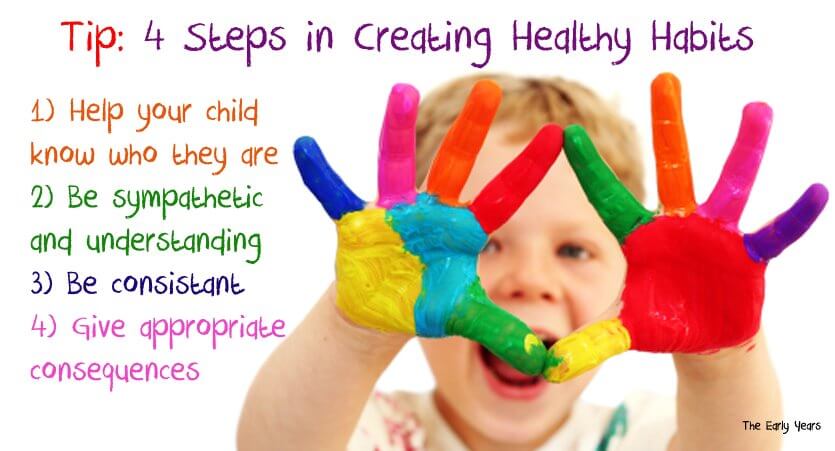Creating Healthy Habits that Will Last a Lifetime
4 Steps every parent can take:
Your child is unique. Each day brings a new discovery. When children are understood, know who they are, guided with confidence, have rules and routines they can count on, are trusted, treated with fairness and kindness, their dignity intact, have role models and are well loved even in unlovable circumstances, it provides the recipe for success.
- Help children know who they are: As parents you are your child’s greatest advocate; you are the one who knows them best. What better person is there than you to teach them about who they are! At the toddler/pre-school age it is important to give them the words which help express their emotions. Here is an example of how you might explain to your child why he or she is angry or sad: “You are so angry because you want me to stay in your bed”… or … “You are really sad because he didn’t want to play with you.”
We want to teach our children about who they are so they know who they are working with.
For example, “You are the kind of boy who needs more time before you run around the gym at parties. When you are ready there’s the slide, there’s the ball corner etc…” Or, for a child who is very shy you might say, “You are the kind of girl who is shy if you don’t know someone well. It’s okay to be shy and meet new people.” For a child who might not like going out all that much, we can begin by positively reinforcing them with, “You are a boy who is really happy to stay home”…. For a child who delays getting ready for school you might encourage them with, “You take a long time to get ready for school in the morning so here’s the plan that’s best for you…”
This approach is very powerful, allowing children to accept who they are while discovering their strengths and weaknesses thereby giving them valid tools to problem solve while keeping their dignity intact.
- Be sympathetic and understanding: Validate how your child feels. “I know you want another ice cream; ice cream is so delicious”… or…. “I know you want that toy right now, it’s fabulous”. When we validate children, it removes 50% of their angst. Someone understands; they have you on their team. In fact, no matter how old one is, validation is a stress reliever and shows compassion.We can allow children to have their say but it doesn’t mean they will always have their way.It is okay to say, “I know you want that cookie. Wouldn’t it be great if we could eat the whole bag…. but that would be bad for our body”. So while we understand their wants, we must still set the boundaries. When a child has had a tantrum and has come out of it, rather than saying, “If you ever scream like that again….” or … “Now that you’ve wasted so much time, you will not have ice cream…” try this instead: “That was tough and I’m so sorry you went through that but the good news is, you can make a better decision next time.”
- Be consistent:Children feel really safe when you are honest with them and follow through. If you tell a child that he will not watch T.V. for a week yet the next day the T.V. is back on again, he will learn that he cannot count on you to be consistent or keep your word when it comes to other areas as well.
We must be truth keepers
You may not always be sure of how to handle a situation. It’s better to do nothing for the moment than to come up with a plan that might later be broken. While it is true that we can make plans which sometimes need to change, giving a consequence because of wrong behavior and not following through tells a child you don’t really care about what happened after all. As well- known author Barbara Coloroso says: “Mean what you say, say what you mean and follow through”.
- Give appropriate consequences: The consequence needs to “match the crime”. That means coming up with something that teaches and does not shame. Consequences should be reasonable, fair and logical.If a child writes on the wall with crayons, we don’t say, “No books at bedtime” or “Go sit on the stairs”. This may be unfruitful since there is no teaching going on. Instead we can say, “Here’s the sponge. Start cleaning and I will keep the crayons in a place where they won’t be used for the wall.” The good news is that you can always present them with the crayons a week later and let them know they can try again.If the toys don’t get picked up at home then the time in the park may need to be postponed.Be careful of an ensuing power struggle that often develops in these types of situations and remember what it is you that you want to teach. You want him/her to be “trained” to clean up and so this is how you can help. Supervise by suggesting he/she start with a particular item, ie “start by putting all your lego pieces back, or “start by picking up all the balls first”. There is no need to lose your cool. Remember to catch your breath and relax if he/she begins a tantrum. The rule must stay the same though, “We go to the park when the toys are cleaned up.” If the toys do not get cleaned up, then the logical consequence can be stated like this: “It took a very long time and now it’s too late to go to the park. The good news is…. we get to try this again tomorrow.”






